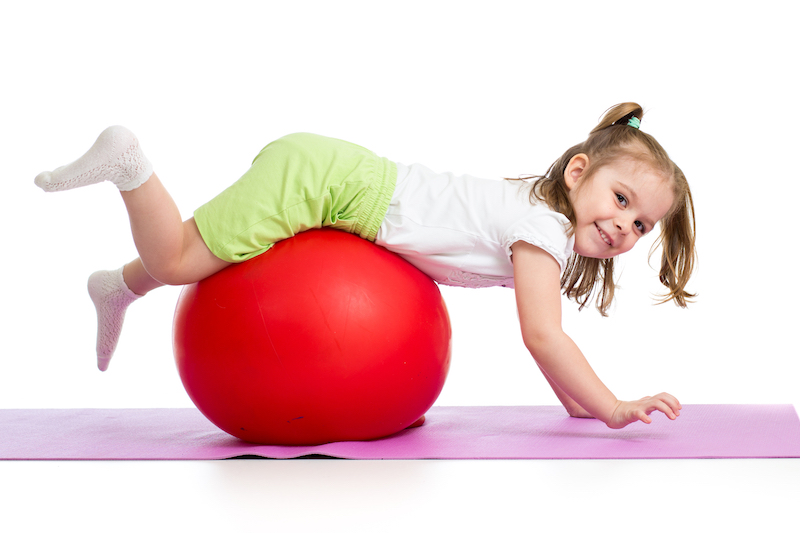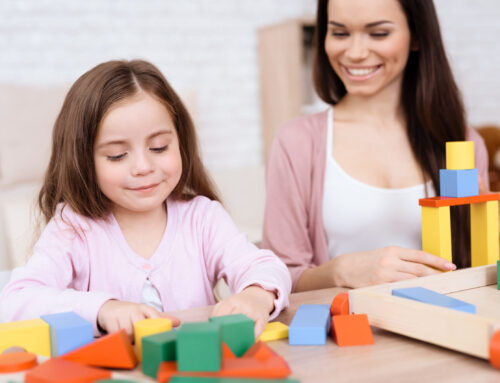
-
- For parents who have actively enrolled their child in occupational or physical therapy services inside or outside of their home, have you noticed some commonalities among therapy equipment? Yes, there are the dozens if not hundreds of toys that fill the pediatric setting but there are additional tools that help a child grow and develop. One of these tools is a plain, ordinary exercise ball. The typical exercise ball varies in size but is made of the same, inflatable and bouncy rubber material. Exercise balls are frequently advertised as a useful and relatively cheap option for adult exercise regimens. What about for children? Why do therapists often introduce an exercise ball to a child? What purpose does it serve?
- An exercise ball meets multi-sensory needs: For a child with sensory processing delays or disorders, an exercise ball provides beneficial stimulation. This may include proprioceptive input (i.e. bouncing on top of the ball, lifting the ball overhead, hitting the ball, etc.), tactile input (i.e. feeling the smooth texture of the ball), vestibular (i.e. balancing on top of the ball, bouncing or rolling over the ball), and auditory (i.e. listening to the sounds of the ball getting hit or bouncing against the floor). Feeding the senses may result in increased emotional regulation.
- It provides an opportunity for playful exercise: Playing with a big, rubber ball takes certain muscle power. Throwing, kicking, bouncing on, or smacking the ball is a great way for a child to release some energy and to work the whole musculature of the body.
- The ball is a great mediator for social participation: Since a giant, rubber ball can be hard for a small child to control it provides a great opening to social interaction with others. This could include siblings, parents, therapists, or friends of the child simply playing a game of catch or kickball.
- It’s a tool for improving gross and fine motor development: All physical interactions with the ball require motor skills of the gross and fine motor nature: throwing with the arms, smacking the ball with the lands, lifting the ball off of the ground, crawling on top of the ball, kicking the ball into the air, etc. Playing with a ball can further improve a child’s overall motor development.
- Using a ball assists with delays in reflex development: Every typical child is born with a set of primitive reflexes. Such reflexes assist with other developmental milestones as the child ages such as motor, cognitive, and social development. Reflexes assist with reactionary movements, such as knowing what to do when there is a loss of balance. Visit Primitive Motor Reflexes & Their Impact on a Child’s Function for more details. Using an exercise ball may assist a child in eliciting delayed or absent reflexes. This is done by carefully planned movements and exercises determined by the child’s therapist.
- An exercise ball can address cognitive development: Effectively playing with an exercise ball requires lots of brain involvement including problem-solving, decision-making, emotional regulation, novel learning, short and long-term memory, attention, etc.
- It’s fun! An exercise ball is a great way to capture a child’s interest for a therapy session because it is fun, interactive, and can be used in endless ways in order to prevent boredom.
An exercise ball is a wonderful therapy tool for children of all ages. However, before parents get too gun-ho about running out and purchasing a ball for your child make sure of the following:
- Talk to your child’s therapist: Consult with your child’s physical and/or occupational therapist, especially if they are already using an exercise ball during therapy sessions. Ask about what goals the therapists are trying to accomplish by using the ball or what developmental skills they are addressing. Have a discussion about how you as a parent or a caregiver can replicate their uses of the ball to best assist their child outside of therapy sessions.
- Always consider your child’s safety: Although an exercise ball is helpful for a child of any age, think about what types of safety concerns could come up. This is especially important for very small children or any child with delayed milestones of any kind. Talk to your therapist about how often or what ways you should be supervising your child when they are playing with the ball.
- Think about your availability: Although playing with a ball by themselves can be fun for a time, a child would greatly benefit from having you around as well. A parent or a caregiver can make an excellent playmate for the child and can introduce them to all sorts of games and two-person interactions that are more exciting and therapeutically appropriate for the child.
- For parents who have actively enrolled their child in occupational or physical therapy services inside or outside of their home, have you noticed some commonalities among therapy equipment? Yes, there are the dozens if not hundreds of toys that fill the pediatric setting but there are additional tools that help a child grow and develop. One of these tools is a plain, ordinary exercise ball. The typical exercise ball varies in size but is made of the same, inflatable and bouncy rubber material. Exercise balls are frequently advertised as a useful and relatively cheap option for adult exercise regimens. What about for children? Why do therapists often introduce an exercise ball to a child? What purpose does it serve?





